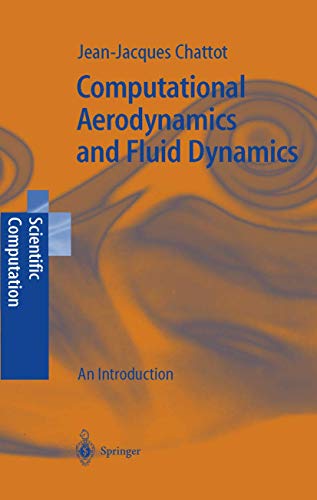Verwandte Artikel zu Computational Aerodynamics and Fluid Dynamics: An Introducti...

Inhaltsangabe
The book gives the reader the basis for understanding the way numerical schemes achieve accurate and stable simulations of physical phenomena. It is based on the finite-difference method and simple problems that allow also the analytic solutions to be worked out. ODEs as well as hyperbolic, parabolic and elliptic types are treated. The book builds on simple model equations and, pedagogically, on a host of problems given together with their solutions.
Die Inhaltsangabe kann sich auf eine andere Ausgabe dieses Titels beziehen.
Von der hinteren Coverseite
This textbook is written for senior undergraduate and graduate students as well as engineers who will develop or use code in the simulation of fluid flows or other physical phenomena. The objective of the book is to give the reader the basis for understanding the way numerical schemes achieve accurate and stable simulations of physical phenomena. It is based on the finite-difference method and simple enough problems that allow also the analytic solutions to be worked out. ODEs as well as hyperbolic, parabolic and elliptic types are treated. The reader also will find a chapter on the techniques of linearization of nonlinear problems. The final chapter applies the material to the equations of gas dynamics. The book builds on simple model equations and, pedagogically, on a host of problems given together with their solutions.
„Über diesen Titel“ kann sich auf eine andere Ausgabe dieses Titels beziehen.
EUR 3,00 für den Versand innerhalb von/der Deutschland
Versandziele, Kosten & DauerNeu kaufen
Diesen Artikel anzeigenGratis für den Versand innerhalb von/der Deutschland
Versandziele, Kosten & DauerSuchergebnisse für Computational Aerodynamics and Fluid Dynamics: An Introducti...
Computational Aerodynamics and Fluid Dynamics: An Introduction (Scientific Computation).
Anbieter: Antiquariat Bernhardt, Kassel, Deutschland
gebundene Ausgabe. Zustand: Sehr gut. Zust: Gutes Exemplar. With 77 Figures, XI, 186 S. Englisch 442g. Artikel-Nr. 489013
Anzahl: 1 verfügbar
Computational Aerodynamics and Fluid Dynamics
Anbieter: buchversandmimpf2000, Emtmannsberg, BAYE, Deutschland
Buch. Zustand: Neu. Neuware -The field of computational fluid dynamics (CFD) has matured since the au thor was first introduced to electronic computation in the mid-sixties. The progress of numerical methods has paralleled that of computer technology and software. Simulations are used routinely in all branches of engineering as a very powerful means for understanding complex systems and, ultimately, improve their design for better efficiency. Today's engineers must be capable of using the large simulation codes available in industry, and apply them to their specific problem by implemen ting new boundary conditions or modifying existing ones. The objective of this book is to give the reader the basis for understanding the way numerical schemes achieve accurate and stable simulations of phy sical phenomena, governed by equations that are related, yet simpler, than the equations they need to solve. The model problems presented here are linear, in most cases, and represent the propagation of waves in a medium, the diffusion of heat in a slab, and the equilibrium of a membrane under distributed loads. Yet, regardless of the origin of the problem, the partial differential equations (PDE's) reflect the physical phenomena to be modeled and can be classified as being of hyperbolic, parabolic or elliptic type. The numerical treatment depends on the equation type that can represent several physical situations as diverse as heat conduction and viscous fluid flow. Non linear model problems are also presented and solved, such as the transonic small disturbance equation and the equations of gas dynamics.Springer Verlag GmbH, Tiergartenstr. 17, 69121 Heidelberg 208 pp. Englisch. Artikel-Nr. 9783540434948
Anzahl: 2 verfügbar
Computational Aerodynamics and Fluid Dynamics : An Introduction
Anbieter: AHA-BUCH GmbH, Einbeck, Deutschland
Buch. Zustand: Neu. Druck auf Anfrage Neuware - Printed after ordering - The field of computational fluid dynamics (CFD) has matured since the au thor was first introduced to electronic computation in the mid-sixties. The progress of numerical methods has paralleled that of computer technology and software. Simulations are used routinely in all branches of engineering as a very powerful means for understanding complex systems and, ultimately, improve their design for better efficiency. Today's engineers must be capable of using the large simulation codes available in industry, and apply them to their specific problem by implemen ting new boundary conditions or modifying existing ones. The objective of this book is to give the reader the basis for understanding the way numerical schemes achieve accurate and stable simulations of phy sical phenomena, governed by equations that are related, yet simpler, than the equations they need to solve. The model problems presented here are linear, in most cases, and represent the propagation of waves in a medium, the diffusion of heat in a slab, and the equilibrium of a membrane under distributed loads. Yet, regardless of the origin of the problem, the partial differential equations (PDE's) reflect the physical phenomena to be modeled and can be classified as being of hyperbolic, parabolic or elliptic type. The numerical treatment depends on the equation type that can represent several physical situations as diverse as heat conduction and viscous fluid flow. Non linear model problems are also presented and solved, such as the transonic small disturbance equation and the equations of gas dynamics. Artikel-Nr. 9783540434948
Anzahl: 1 verfügbar
Computational Aerodynamics and Fluid Dynamics: An Introduction
Anbieter: Anybook.com, Lincoln, Vereinigtes Königreich
Zustand: Good. This is an ex-library book and may have the usual library/used-book markings inside.This book has hardback covers. In good all round condition. Please note the Image in this listing is a stock photo and may not match the covers of the actual item,500grams, ISBN:9783540434948. Artikel-Nr. 5585468
Anzahl: 1 verfügbar
Computational Aerodynamics and Fluid Dynamics
Anbieter: Ria Christie Collections, Uxbridge, Vereinigtes Königreich
Zustand: New. In. Artikel-Nr. ria9783540434948_new
Anzahl: Mehr als 20 verfügbar
Computational Aerodynamics and Fluid Dynamics: An Introduction
Anbieter: Revaluation Books, Exeter, Vereinigtes Königreich
Hardcover. Zustand: Brand New. 186 pages. 9.25x6.25x0.75 inches. In Stock. Artikel-Nr. x-3540434941
Anzahl: 2 verfügbar

